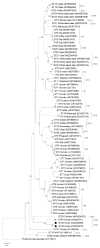Diversity of Blastocystis Subtypes in Horses in Colombia and Identification of Two New Subtypes
- PMID: 36144295
- PMCID: PMC9505074
- DOI: 10.3390/microorganisms10091693
Diversity of Blastocystis Subtypes in Horses in Colombia and Identification of Two New Subtypes
Abstract
Blastocystis is a common intestinal protist in humans and animals worldwide. Wild and domestic animals are thought to be reservoirs of Blastocystis subtypes that also infect humans. There are limited studies on the prevalence and subtype distribution of Blastocystis in horses. In this study, 185 fecal samples were collected from horses (1 month to 17 years of age) in four regions of Colombia (Sabana de Bogotá, Costa Atlántica, Llanos Orientales, and Bogotá D.C.). Blastocystis presence and subtypes were determined by PCR and next generation amplicon sequencing. Eighty-one (43.8%) horses were positive for Blastocystis, with positive horses in all four regions. Molecular characterization identified 12 Blastocystis subtypes, 10 known subtypes (ST1, ST3-ST6, ST10, ST14, ST25, ST26), and 2 novel subtypes (ST33 and ST34). The validity of the novel subtypes was confirmed via phylogenetic and pairwise distance analyses of the full-length SSU rRNA gene sequences. Mixed subtype infections were common (55.6% of Blastocystis-positive horses). ST10 was the most prevalent subtype, present in 82.8% of Blastocystis-positive horses. Potentially zoonotic subtypes were identified in 88.9% of the Blastocystis-positive horses. This constitutes the most comprehensive study of Blastocystis in horses. Our findings indicate that horses harbor potentially zoonotic subtypes and could contribute to the transmission of Blastocystis to humans.
Keywords: Blastocystis; Colombia; Illumina; MinION; NGS; epidemiology; horses; subtypes.
Conflict of interest statement
The authors declare no conflict of interest.
Figures

Similar articles
-
Identification of Multiple Blastocystis Subtypes in Domestic Animals From Colombia Using Amplicon-Based Next Generation Sequencing.Front Vet Sci. 2021 Aug 24;8:732129. doi: 10.3389/fvets.2021.732129. eCollection 2021. Front Vet Sci. 2021. PMID: 34504891 Free PMC article.
-
Blastocystis genetic diversity in animal and human samples from different departments of Colombia using complete sequencing of the 18S rRNA gene (SSU rRNA) by Oxford Nanopore Technologies (ONT).Acta Trop. 2024 Jan;249:107090. doi: 10.1016/j.actatropica.2023.107090. Epub 2023 Dec 2. Acta Trop. 2024. PMID: 38048971
-
Wide Genetic Diversity of Blastocystis in White-Tailed Deer (Odocoileus virginianus) from Maryland, USA.Microorganisms. 2021 Jun 21;9(6):1343. doi: 10.3390/microorganisms9061343. Microorganisms. 2021. PMID: 34205799 Free PMC article.
-
Molecular Epidemiology, Subtype Distribution, and Zoonotic Importance of Blastocystis sp. in Camelids (Camels and Alpacas): A Worldwide Systematic Review and Meta-Analysis.Foodborne Pathog Dis. 2024 Nov 8. doi: 10.1089/fpd.2024.0059. Online ahead of print. Foodborne Pathog Dis. 2024. PMID: 39513936 Review.
-
Epidemiology of Blastocystis sp. infection in China: a systematic review.Parasite. 2019;26:41. doi: 10.1051/parasite/2019042. Epub 2019 Jul 16. Parasite. 2019. PMID: 31309925 Free PMC article.
Cited by
-
Prevalence and Multilocus Genotyping of Giardia duodenalis in Donkeys in Shanxi Province, North China.Animals (Basel). 2023 Dec 6;13(24):3771. doi: 10.3390/ani13243771. Animals (Basel). 2023. PMID: 38136808 Free PMC article.
-
Extensive prevalence and significant genetic differentiation of Blastocystis in high- and low-altitude populations of wild rhesus macaques in China.Parasit Vectors. 2023 Mar 17;16(1):107. doi: 10.1186/s13071-023-05691-7. Parasit Vectors. 2023. PMID: 36932438 Free PMC article.
-
Circulation and colonisation of Blastocystis subtypes in schoolchildren of various ethnicities in rural northern Thailand.Epidemiol Infect. 2023 Apr 27;151:e77. doi: 10.1017/S0950268823000596. Epidemiol Infect. 2023. PMID: 37185159 Free PMC article.
-
First Molecular Identification and Subtyping of Blastocystis sp. in the Most Consumed Edible Marine Fish of Iran: A Foodborne Concern.Acta Parasitol. 2024 Mar;69(1):446-452. doi: 10.1007/s11686-023-00769-9. Epub 2024 Jan 6. Acta Parasitol. 2024. PMID: 38183610
-
A longitudinal study of Blastocystis in dairy calves from birth through 24 months demonstrates dynamic shifts in infection rates and subtype prevalence and diversity by age.Parasit Vectors. 2023 Jun 2;16(1):177. doi: 10.1186/s13071-023-05795-0. Parasit Vectors. 2023. PMID: 37264466 Free PMC article.
References
-
- Rojas-Velázquez L., Maloney J.G., Molokin A., Morán P., Serrano-Vázquez A., González E., Pérez-Juárez H., Ximénez C., Santin M. Use of next-generation amplicon sequencing to study Blastocystis genetic diversity in a rural human population from Mexico. Parasites Vectors. 2019;12:566. doi: 10.1186/s13071-019-3814-z. - DOI - PMC - PubMed
Grants and funding
LinkOut - more resources
Full Text Sources
Other Literature Sources

